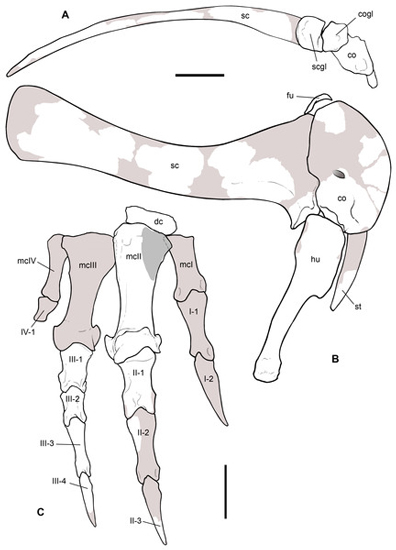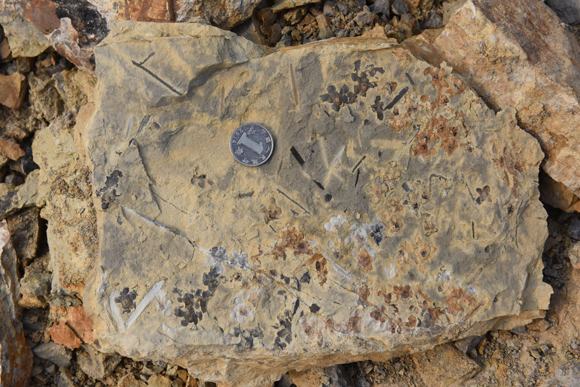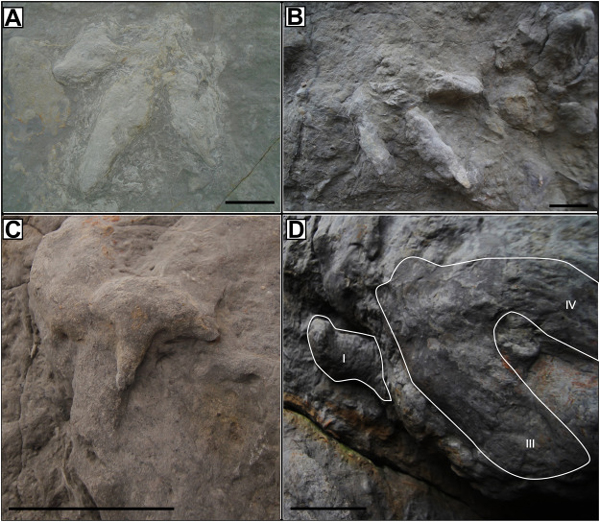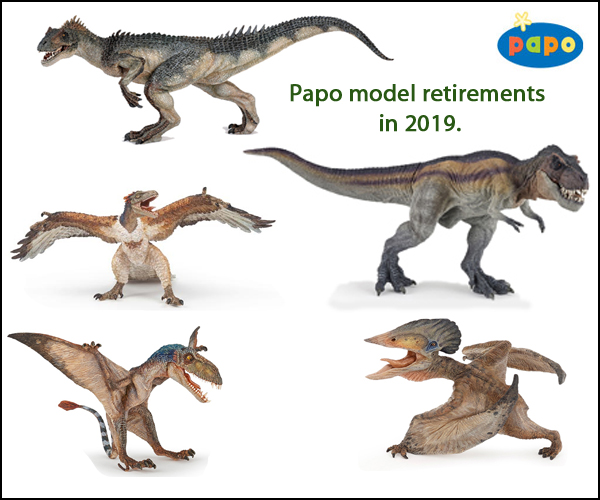New Giant Early Jurassic Predator from Italy
Saltriovenator zanellai – One Tonne Giant and Oldest Ceratosaurian Described to Date
Scientists from Natural History Museum of Milan and the Geological Museum of Bologna (Museu di Storia Naturale di Milano and the Museo Geologico), have published a scientific paper on a new predatory dinosaur from the Lombardy region of northern Italy. This new species was a giant, weighing around a tonne and measuring approximately 7.5 metres in length. It lived some 25 million years before other known big predatory dinosaurs evolved and examination of the fossilised bones suggest that this dinosaur was still growing when it died. The dinosaur has been named Saltriovenator zanellai and it is the largest theropod described to date from the Early Jurassic (Sinemurian faunal stage).
A Life Reconstruction of the Newly Described Ceratosaurian Theropod Saltriovenator zanellai
Picture credit: Davide Bonadonna
A Chance Discovery
Saltriovenator was discovered by chance in the summer of 1996 by amateur fossil collector Angelo Zanella, whilst exploring fossil rich limestone layers associated with a marble quarry near the town of Saltrio (Varese Province, Lombardy). The strata containing the fossilised remains represent marine deposits and explosives used in the quarrying process had broken up the fossil bearing layer into hundreds of pieces. In total, 132 fossil pieces were excavated from the site, the remains of a single animal.
The bones show feeding traces from fish and borings from marine invertebrates. The palaeontologists writing in the on-line academic journal “PeerJ” suggest that the carcase was washed out sea and stayed on the seabed for some time, permitting the scavenging to take place.
Fossil Elements Used to Confirm Ceratosaurian Affinity with a Skeletal Drawing

Picture credit: G. Bindellini, C. Dal Sasso and M. Zilioli and M. Auditore
The picture above shows key fossils that helped to classify Saltriovenator as a member of the Ceratosauria clade, it is the oldest ceratosaur described to date.
Key
A, B, C = views of the right humerus.
D = left scapula.
E = right scapular glenoid and coracoid.
F = furcula (wishbone).
G = single tooth from the anterior portion of the lower jaw.
I = partial left humerus, the circular depressions represent borings made by marine invertebrates feeding on the carcase.
J, L, N = views of the right second metacarpal (finger bone).
K, M, O, = views of the right second digit.
P-T = views of the right third digit.
U = distal tarsal IV.
V, X = third right metatarsal views.
W, Y = second right metatarsal views.
Z = reconstructed skeleton of Saltriovenator with identified fossil elements shaded red.
Scale bars: 10 cm in (A)–(E), (I), and (U)–(Y); two cm in (F), and (J)–(T); one cm in (G).
A Skeletal Reconstruction of Saltriovenator zanellai

Picture credit: M. Auditore
The First Jurassic Dinosaur from Italy
Saltriovenator is the first dinosaur to be described from fossils found in the Italian Alps. It is the first dinosaur from the Jurassic Period to have been found in Italy and the country’s second theropod, the first being Scipionyx samniticus which lived during the Early Cretaceous and at just over two metres in length, was considerably smaller than S. zanellai. A study of growth rings found in a cross-sectional analysis of the fossil bones indicates that the dinosaur was around twenty-four years of age when it died.
It was still growing, albeit slowly, so the maximum size of this predator is not known, although at an estimated 7.5 metres long, it was considerably bigger than any other theropod from the Early Jurassic described to date.
CollectA have produced a replica of Saltriovenator.
To view this model range: CollectA Deluxe Prehistoric Life Models.
Saltriovenator zannellai – A Mosaic of Basal and More Advanced Theropod Features
Saltriovenator exhibits a mosaic of features seen in four-fingered theropods and basal tetanuran dinosaurs. The fossilised finger bones indicate that this dinosaur had a fully functioning four-fingered hand, well-adapted for grasping and coping with struggling prey. Later ceratosaurs had only three fingers on each hand. Study of the finger bones will help scientists to understand better the evolutionary relationships between the four-fingered cilophosaurs, ceratosaurs and later types of theropod such as the allosaurs with their atrophied hands.
Views of the Pectoral Girdle and the Right Hand of Saltriovenator zanellai

Picture credit: M. Auditore
Commenting on the importance of this fossil discovery, one of the authors of the scientific paper, Dr Andrea Cau (Museo Geologico), stated:
“The grasping hand of Saltriovenator zanellai fills a key gap in the theropod evolutionary tree: predatory dinosaurs progressively lost the pinkie and ring fingers and acquired the three-fingered hand which is the precursor of the avian wing.”
A spokesperson from Everything Dinosaur commented:
“The evolution of large, powerful predatory dinosaurs at the very beginning of the Jurassic, may have been a factor in the evolution of bigger and bigger herbivorous dinosaurs such as the sauropods. Think of it as an evolutionary arms race as carnivores got bigger, selection pressure was put on herbivores to become bigger and stronger themselves in order to avoid predation.”
Visit the Everything Dinosaur website: Everything Dinosaur.






























